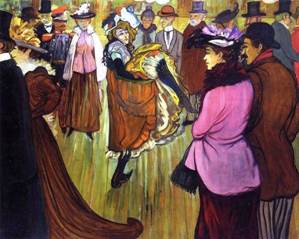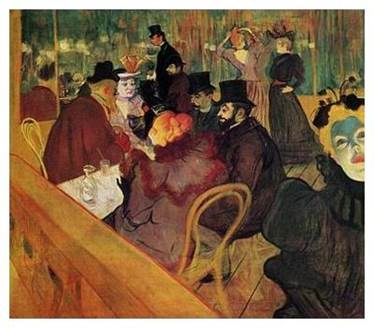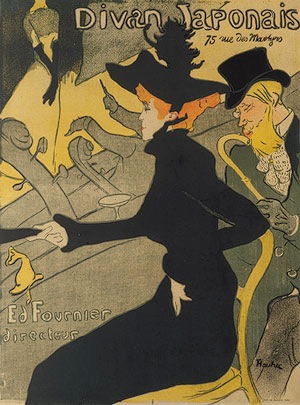Henri de
Toulouse-Lautrec
(French, 1864-1901)
Henri Marie Raymond de Toulouse-Lautrec-Monfa, more commonly known as Henri de Toulouse-Lautrec, was born November 24, 1864. He was the first born son of Count Alphonse and Countess Adele de Toulouse-Lautrec; the count and countess were first cousins from a wealthy family.
Due to the inbreeding of his parents, Henri suffered from a brittle bone disease among other ailments. He broke his right leg at the age of thirteen and his left leg at the age of fourteen. After these major breaks, his legs stopped growing, but his torso continued to mature into that of a grown man.

Le Moulin Rouge, 1893

Le Moulin Rouge, 1892
As odd as his physical appearance was, his disability was possibly the reason he became an artist. Unable to participate in the same activities as his better abled peers, Toulouse-Lautrec studied art and became a talented painter, illustrator, and print maker.
He is best known for his depictions in the French night life. He lived and painted in the local brothels, attended theatre performances at the cabaret, and frequented the local bars. The people he met at these locations would become the subjects of his most famous works of art.
Through richly pigmented color and an effortless ability to convey movement, Henri painted thousands of canvases depicting the nightlife he was so fond of.
Stylistically he is categorized as a Post-Impressionist; taking inspiration from Impressionists such as Monet and Degas. In addition to those influences, Henri admired the work of Japanese print makers and adopted a similar style in his own prints.
Similar to the Japanese print makers, Henri would use large areas of flat color, strong angles, dark lines, and cropped figures. Experimenting with Japanese composition whenever possible. He was fortunate to discover this style at time in history that allowed for him to be very experimental.
New technology made it possible to create larger prints than were possible before, with vivid colors, and variances in texture. Local businesses began to commission Toulouse-Lautrec to create posters to help them advertise. He made a name for himself as a poster artist.


Divan Japonais, 1893
The bohemian lifestyle he enjoyed became more frequently a source of inspiration for his work. He began to interact more intimately with the prostitutes he knew and, while living in the brothels, he began to paint intimate details about their lives.
One painting that depicts an intimate backstage view, is the well known painting Woman Before a Mirror. It is an image of a nude, red headed, prostitute, standing before a mirror. Her gaze is on herself, but the mirrored image allows the viewer to see the entire figure. She is neither idealized nor demonized for who she is, or where she is. The woman is simply a flesh and blood figure, gazing into her own eyes without shame or fear.
Paintings like this gained Henri a reputation for having an ability to expose humanity in his subjects. This made his nudes different than many other artist’s nudes, which were often depictions of symbolic heroines.
Unfortunately, for Toulouse-Lautrec, the bohemian lifestyle was not just a way to glean artistic inspiration. He lived the wild, untamed life, to it’s fullest and his health declined quickly because of it. While living in the brothels he contracted syphilis, most likely from a prostitute named Rosa la Rouge.
He was a ragging alcoholic for most of his adult life, and had ways of remaining intoxicated at all times, mostly to avoid social interactions. He always had a flask of absinth on hand, and was known to have a hidden chamber in his cane to hide it.
His production of work began to decline, and Henri suffered multiple mental and physical break downs. A combination of the alcoholism and the syphilis, Henri often believed that he was being stalked by the police. By 1899 he was so mentally unstable that he was committed to a mental institute for three months.

Woman Before a Mirror, 1897
At the sanitarium he painted circus scenes from memory. He gathered his strength, and news of his break down spread throughout France. His status as a celebrity grew, and the prices people were paying for his paintings increased.
Shortly after being released from the hospital, he suffered multiple strokes. Caused by a combination of the alcoholism and the syphilis. On September 9, 1901, Henri de Toulouse-Lautrec passed away at his family’s home. He was only thirty six years old.
